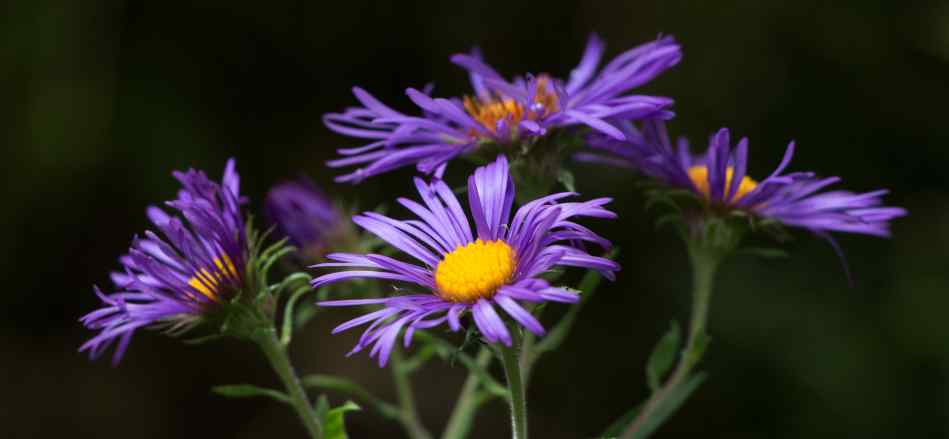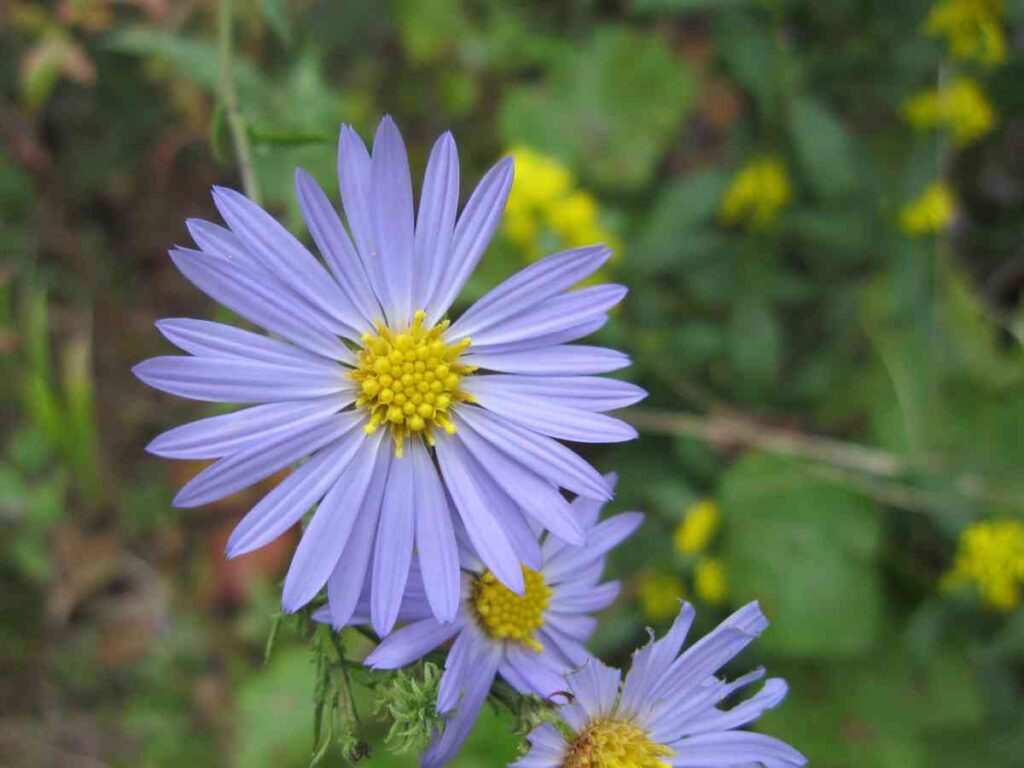While most flowering plants bloom in Spring and Summer, there are few plants that can brighten your backyard with vibrant hue blossoms in the fall.
Asters are one of the prominent fall blooming plants that grace your garden with purple, pink, blue and white coloured blossoms.
Not just for aesthetics, these hardy perennials attract pollinators to your fall vegetable garden.
For fall blooming asters, you must be planted them in spring or early summer. You can even plant them in fall, but you should wait until next season for blooms.
Once the plant is established it returns every year with colourful blossoms every year.
New England aster and New York aster are two prominent aster species that are known for late-season blooming.
These hardy perennials can be grown in most USDA zones with minimal care that includes 6 hours of sunlight, well-drained soil and adequate water.
Depending on climatic conditions in your region, you may need to take extra care to prevent drought and overwatering.
Let’s now dive deep into growing requirements and planting asters.
Growing Requirements for Asters

Asters thrive best when planted in full sun, where they can soak up at least six hours of direct light each day. While they can handle a touch of light shade, especially in hotter regions, too much shade often leads to fewer flowers and leggy growth.
Soil: These fall favorites prefer well-drained, organically rich soil. They do not like soggy ground, which can quickly lead to root problems. A slightly acidic to neutral soil pH between 6.0 and 7.0 works best. Before planting, mix compost or well-rotted manure into the soil to boost fertility and help with moisture retention.
Spacing: Give asters some breathing room. Depending on the variety, they should be spaced 1–3 feet apart. This not only allows each plant to grow to its full potential but also encourages good air circulation, which is important for keeping fungal diseases—like powdery mildew—at bay.
Watering: During their first season, keep the soil consistently moist so the roots establish well. Once mature, many varieties are fairly drought-tolerant, needing only occasional watering during dry spells. Avoid waterlogging, as asters dislike sitting in wet soil. Applying a layer of mulch helps lock in moisture and keep the roots cool through summer heat.
Container Growing: If you’re short on space, asters can also be grown in pots. Compact varieties are the best choice for containers since they won’t outgrow the space.
Use a high-quality, well-draining potting mix and remember that container-grown plants dry out more quickly than those in the ground, so they’ll need watering more often—sometimes daily during hot weather.
Regular feeding with a balanced liquid fertilizer will also help potted asters stay healthy and full of blooms.
When to Plant Asters for Fall Blooming?
If you want your asters to put on a brilliant show in autumn, timing is everything. The best time to plant them is in spring or early summer
Planting early gives the roots plenty of time to establish before the cooler months arrive, ensuring that by late summer and fall the plants are strong, healthy, and ready to burst into bloom.
Asters are perennials, so once settled in, they’ll come back year after year. Planting in April through June is ideal for most regions of the U.S., though gardeners in warmer climates may be able to plant a little later.
If you wait until mid-to-late summer to put them in the ground, the plants may survive but might not flower much in their first season because they won’t have had time to settle.
That said, many garden centers sell asters in pots already in bloom during the fall season. These can be planted directly into the garden or enjoyed in containers as “instant color.”
While they add immediate beauty, think of them as an investment for next year—once they overwinter, they’ll reward you with even more blooms the following fall.
Important Tip: Always plant asters in a sunny spot with well-drained soil. Water regularly after planting to help roots establish, and mulch to conserve moisture through summer heat.
How to Grow Asters for Fall Blooming?

1. Choose Healthy Plants
Select strong, disease-free asters with firm stems, green leaves, and plenty of buds. If dividing an existing plant, choose mature clumps with well-established roots. Healthy plants are more likely to thrive and produce abundant fall blooms.
2. Plan Your Layout
Decide where each plant will go in your garden. Taller varieties, like New England asters, look best at the back of borders, while shorter types, such as Heath or Aromatic asters, can go in front or along walkways. Space plants 1–3 feet apart to allow room for growth and proper air circulation.
3. Prepare the Planting Hole
Dig a hole slightly larger than the root ball. For multiple plants, mark their positions in advance to maintain even spacing. Proper hole preparation ensures that roots have room to spread and settle.
Also Read: 19 Fall Wildflowers for Late Season Color
4. Plant Carefully
Gently remove the aster from its container or division. Loosen any tightly packed roots. Place the plant so that the crown—the point where stems meet roots—is level with the surrounding soil. Avoid planting too deep, which can damage the plant.
5. Backfill and Firm the Soil
Fill in soil around the roots and press lightly to remove air pockets. Make sure the plant is upright and stable, but don’t compact the soil too hard, as roots need room to grow.
6. Water Immediately
Water the newly planted asters thoroughly to help settle the soil around the roots. This reduces transplant shock and encourages the plant to establish quickly.
7. Grouping and Design Tips
Plant asters in clusters rather than single rows for a natural, flowing look. Mix taller and shorter varieties to create layers and depth. For containers, place taller varieties in the center and compact or trailing types around the edges.
8. Timing for Fall Bloom
Plant asters in spring or early summer. This timing gives the plants enough time to develop strong roots and foliage, ensuring a vibrant display of blooms in late summer and fall.
9. Monitor During Establishment
Keep an eye on new plants for the first few weeks. Avoid disturbing roots and watch for signs of stress. Once established, asters are hardy and will bloom reliably year after year.
Also Read: How to Plant Tulips in the Fall?
How to Care Asters in Fall?

Deadheading spent flowers is important to keep asters looking tidy and encourage them to produce more blooms. Regularly removing faded flowers also prevents the plant from going to seed too early, allowing it to focus energy on new blossoms.
Tall varieties, like New England asters, can become top-heavy during their peak bloom. Providing stakes or plant supports helps prevent stems from bending or breaking in windy autumn weather.
Applying a layer of mulch around the base of your asters helps retain moisture and keeps roots protected from cooler temperatures. Mulching also helps prevent soil from drying out during late-season heat or early frosts.
While mature asters are fairly drought-tolerant, fall is their prime blooming season, so keep an eye on soil moisture. Water as needed to keep the soil evenly moist, but avoid waterlogging, which can harm the roots.
Asters can be prone to fungal issues like powdery mildew, rust, or leaf spots in humid fall weather. Ensure good air circulation between plants and remove any affected leaves promptly to maintain plant health.
A light application of balanced fertilizer in early fall can help extend flowering, but over-fertilizing may encourage leafy growth instead of blooms.
After the first frost, trim asters down to about 2–3 inches above the ground. This helps prevent disease and prepares the plants for winter dormancy. In colder regions, adding an extra layer of mulch offers additional protection to the roots.
Fall-blooming asters also attract pollinators like bees and butterflies when other flowers are scarce. Leaving some blooms for wildlife ensures a lively, healthy garden while giving you the joy of watching pollinators in action.
Also Read: How to Plant Pansies in Fall?
Conclusion
Asters are a true highlight of the fall garden, bringing vibrant color and life when many other flowers are fading.
With the right planting, care, and attention to seasonal needs, these hardy perennials reward gardeners with long-lasting blooms, attract pollinators, and add beauty to borders, beds, and containers alike.
By planning ahead and following simple care steps, you can enjoy a spectacular autumn display year after year, making asters a reliable and charming addition to any garden..

Khaja Moinuddin, a computer science graduate, finds joy in gardening and homesteading. Join him on this blog as he shares his experiences in homesteading, gardening, and composting